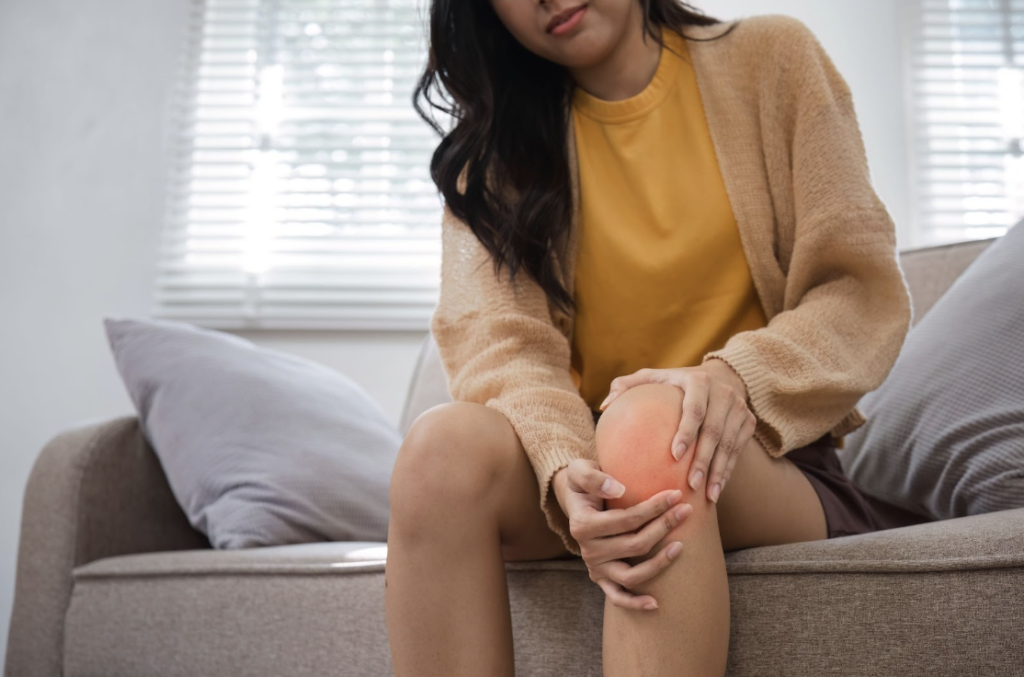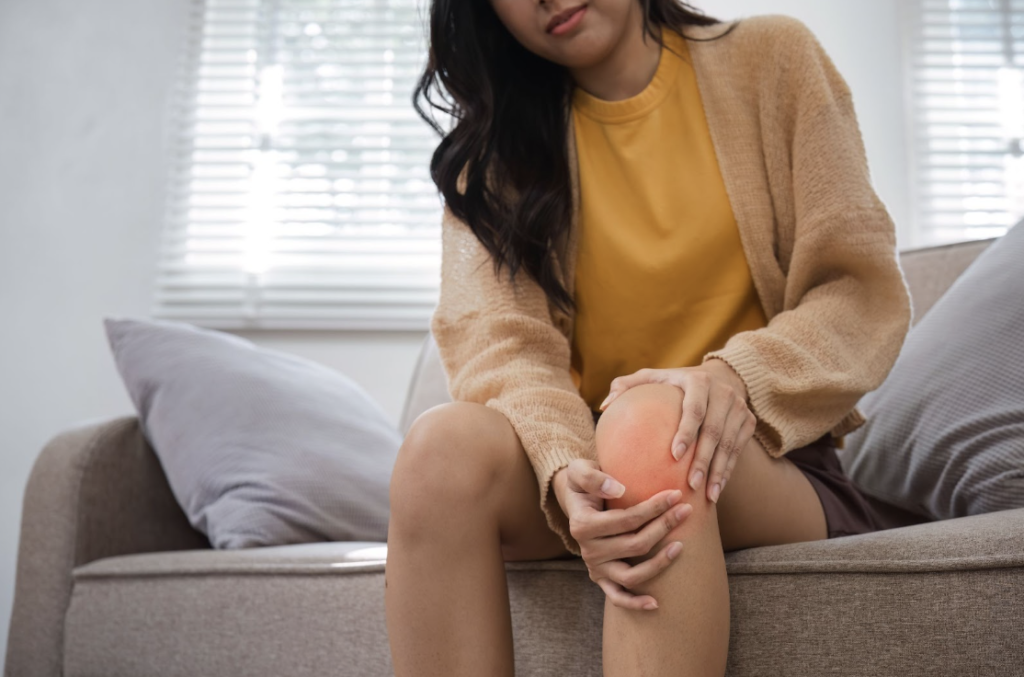Becoming a new mom is an amazing journey, but it can also bring some unexpected aches and pains, like knee pain postpartum.
If you’re feeling this, know that you’re not alone. I’ve worked with many new moms who are experiencing the same thing, and I’m here to help you.
Knee pain can really put a damper on your day, especially when you’re already busy taking care of your baby.
Simple things like lifting your little one, getting out of bed, or even just walking around the house can suddenly feel like a big challenge. But don’t worry, there are ways to ease the pain, make things easier for you, and allow you to focus more on yourself and your baby, and less on your knees.
In this blog post, I’m going to share five practical tips to help you find relief from knee pain postpartum that you can fit into your busy life and help you feel more comfortable.
Let’s explore these tips together and get you back to enjoying every moment with your little one!
Table of Contents
5 Ways To Get Relief From Knee Pain Postpartum

1. Gentle Exercises
I know exercise might be the last thing on your mind right now, though including some light exercises into your day can make a big difference in reducing postpartum knee pain.
To help reduce the pain, it’s important to focus on strengthening the muscles around your knees, which can help support the knee joint better.
Start with simple exercises like walking. Just a short walk around the house or a stroll outside with your baby can make a difference.
If you’re feeling up to it and you’ve been cleared by your healthcare provider, you can also try gentle squats. Stand with your feet hip-width apart, lower your body as if you’re about to sit in a chair, and then slowly rise back up. Keep it slow and controlled—there’s no need to rush.
Depending on where you are in your postpartum recovery, another great exercise is leg lifts.
While lying on your back, bend one knee with your foot flat on the floor, and lift the other leg straight up. Hold for a few seconds, then lower it back down. Switch legs and repeat. This helps strengthen your leg muscles without putting too much strain on your knees.
These exercises are easy to fit into your day, even with a newborn. Plus, they can really help improve muscle support and flexibility, making everyday movements less painful.
If you would like some support and help with finding the best exercises for you and your body, please reach out to me here – I would love to support you.
2. Proper Posture and Lifting Techniques
As a new mom, you’re constantly picking up your baby, bending over, and likely spending a lot of time sitting while nursing or rocking your little one to sleep. Over time, all of these activities can put a strain on your knees if not done correctly.
But there are some simple changes you can make to your posture that can help ease knee pain after pregnancy.
Good Posture: When standing, keep your feet hip-width apart, distribute your weight evenly on both legs, and avoid locking your knees.
It may help to imagine a string pulling you up from the top of your head—this will help you stand tall and straight.
When sitting, especially for long periods, make sure your back is supported, your feet are flat on the floor, and your knees are at a right angle. While this can be tricky to remember when feeding your baby, do your best to avoid slouching or leaning forward, as this can put extra pressure on your knees and lower back
Proper Lifting Techniques: Now, let’s talk about lifting. Whether it’s your baby, a diaper bag, or the laundry basket, using the correct lifting technique can prevent unnecessary strain on your knees.
Here’s how to do it:
- Bend at your knees, not your waist: When picking something up from the floor, bend your knees and squat down rather than bending at the waist. This keeps the strain off your back and distributes the weight more evenly through your legs.
- Keep the load close: Hold the object (or your baby) close to your body. This reduces the leverage effect and makes the load feel lighter, putting less stress on your knees and back.
- Engage your core: Gently engage your abdominal muscles as you lift. This provides extra support to your spine and helps stabilize your body.
- Avoid twisting: Make sure to lift and turn with your feet, not your back as twisting while lifting can increase the risk of injury.
3. Stretching
It’s incredible how a few simple stretches can help when it comes to easing knee pain postpartum.
Stretching is wonderful to do any time of day to help relax, release tension and improve your flexibility making everyday movements feel so much easier and comfortable.
When your muscles are tight, they can pull on your joints and cause pain. Stretching helps lengthen these muscles, reducing tension and increasing your range of motion.
Here are some simple stretches to try to help knee pain postpartum:
- Hamstring Stretch: Sit on the edge of a chair with one leg extended straight out and the other foot flat on the floor. Lean forward gently from your hips, keeping your back straight, until you feel a stretch in the back of your extended leg. Hold for 20-30 seconds, then switch sides.
- Calf Stretch: Stand facing a wall with your hands on the wall at shoulder height. Step one foot back, keeping it straight, and bend your front knee. Press your back heel into the ground and hold for 20-30 seconds. Switch legs and repeat.
- Quad Stretch: Stand on one leg (hold onto a chair for balance if needed), bend your other knee, and bring your heel toward your buttocks. Hold your ankle with your hand and gently pull your heel closer until you feel a stretch in the front of your thigh. Hold for 20-30 seconds, then switch sides.
Just a few minutes of stretching a day can make a big difference to how you feel and can help with postpartum joint pain.
4. Ice and Heat Therapy For Knee Pain Postpartum
Now, let’s talk about the soothing benefits of ice and heat therapy for managing knee pain postpartum.
When to Use Ice: Ice is amazing for reducing inflammation and easing sharp pain. If your knees are swollen or feel particularly sore after a busy day, applying ice can help bring down the swelling and provide relief.
- How to Use: Wrap an ice pack or a bag of frozen peas in a thin towel (never apply ice directly to the skin). Place it on your knee for 15-20 minutes at a time. You can repeat this a few times a day as needed, making sure to take breaks in between.
When to Use Heat: Heat therapy is great for relaxing and loosening tissues, and stimulating blood flow to the area. It’s especially soothing if your knees feel stiff and achy.
- How to Use: Use a heating pad, warm towel, or take a warm bath to apply heat to your knees. Apply the heat for 15-20 minutes at a time. This can be especially comforting in the morning to ease stiffness or at night to relax before bed.
Alternating Ice and Heat: Sometimes, alternating between ice and heat can provide the best of both worlds. Start with ice to reduce any swelling, then switch to heat to relax the muscles and improve blood flow.
Using these therapies can be a quick and effective way to manage knee pain postpartum and keep you feeling more comfortable throughout the day.
5. Supportive Footwear
After pregnancy, your body goes through numerous changes, including your feet!
And wearing unsupportive shoes can make knee pain worse by not giving your body the alignment and support it needs.
Here are some things to look out for when choosing shoes to support you during postpartum (and any time in your life!)…
- Good Arch Support: This helps distribute your weight more evenly and reduces pressure on your knees.
- Cushioning: Good cushioning helps to absorb shock and reduce the impact on your knees, especially if you’re walking or standing for long periods of time.
- Proper Fit: Shoes that are too tight or too loose can cause discomfort and affect your gait, leading to knee pain.
- Stability: Choose shoes with a stable base and avoid high heels, which can throw off your balance and increase the strain on your knees.
Examples of Supportive Footwear: Athletic shoes with good arch support and cushioning, orthopedic shoes, or custom insoles can all provide the necessary support. It might be worth investing in a good pair of shoes or orthotics designed to support your feet and knees properly.
By paying attention to your footwear, you can significantly reduce knee pain and prevent further discomfort. It’s a small change that can make a big impact on your daily comfort and overall well-being.
Would You Like Some Support on Your Postpartum Journey?
Dealing with knee pain postpartum can be challenging, but with support, you can find relief and get back to enjoying time with your new baby.
Remember, you don’t have to go through this alone. If you’re struggling with knee pain or any other postpartum issues, I’m here for you and ready to support you every step of the way.
Please get in touch here, and we can work together to help you feel better.
Warmly,
Nancy
FAQ
How long does postpartum joint pain last?
It depends, but most joint pain eases within a few months. Hormones like relaxin can stick around while you’re breastfeeding, which may delay full recovery. If the pain lingers or worsens, it’s worth checking in with a physical therapist.
Is knee pain normal postpartum?
Yes, knee pain is surprisingly common after having a baby. Your body’s still adjusting, especially after months of extra weight, shifting posture, and loosened joints.
Can breastfeeding make your knees hurt?
It can, indirectly. The hormone relaxin stays in your system while breastfeeding, which can keep joints loose and less stable especially in the knees. Add in awkward feeding positions or carrying your baby often, and your knees can feel it.

